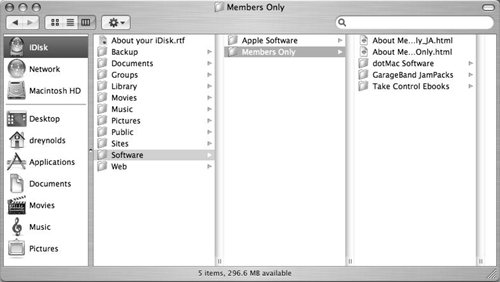| Your .Mac account comes with 1 GB of online storage that you can divide between your iDisk and your .Mac Mail account. When divvying up storage capacity, however, keep in mind that your 1GB of iDisk space also serves as storage for a slew of .Mac services, including Backup, iCal, Sync, .Mac Slides Publisher, Groups, HomePage, iWeb, iPhoto, iMovie, and iCards. In fact, your iDisk comes populated with several folders, some of which already contain files (Figure 3.1). You'll find the folder structure familiarit's similar to the one in Mac OS X's home folder. Here's a look at what each folder is for and what's in each one (if anything). Figure 3.1. Your iDisk comes with several folders already on it. Some of these folders are empty, and some contain files (such as software from Apple and files you may have put there through HomePage, iWeb, Backup, or Sync). 
Backup. This folder is used by the Backup software that comes with your .Mac subscription. If you haven't used Backup, this folder will hold just one file that explains the purpose of the folder. If you have used Backup, the files you've chosen to back up will be here. The folder is read-onlythat is, you can view the files and download them to your hard disk, but you can't upload anything into the folder. That's something only Backup can do. Documents. This is a convenient place to hold your various documents if you need to access them online. It's also a good place to back up important documents (although Backup can take care of this for you). Groups. This folder holds the files associated with any groups that you create. (See Chapter 7 for more on .Mac Groups.) Library. This folder may or may not exist for you, depending on whether you've used an application that uses .Mac. The Library folder isn't really for your use rather, it's a place where applications that work with .Mac can store their own data. You can browse this folder, but since there's nothing really useful here, it's probably best to just leave well enough alone. Movies. You can store movies you want to share in this folder. Movies in this folder are available to HomePage so that you can easily create Web pages with them. If you create a movie page with iWeb, those movies are located in the Web folder instead. (HomePage is covered in Chapter 4, and Chapter 5 is all about iWeb.) Music. You can use the Music folder to store music. If you create a page with music or sound files using iWeb, those files are stored in the Web folder instead. Pictures. This folder (as its name implies) is where you store digital photos and other pictures. Pictures in this folder are made available to HomePage for publishing photo galleries and to iCards for sending custom iCards. If you create a page with photos using iWeb, those photos are stored in the Web folder instead. Public. The Public folder is meant for sharing files with others. You can put anything in it that you like, and others can download those files at will (depending on how you have your Public folder set up). Sites. The Sites folder is where you store Web pages for others to view when they connect to your .Mac Web site. When you use HomePage on .Mac, it creates HTML files and the folders to hold them here as well. If you've created a site using iWeb, those site pages are stored in the Sites folder nested in the Web folder. Software. The Software folder is divided into two parts: Apple Software and Members Only. The contents of these folders consist of downloadable bits of software, all for your use, and they don't count toward your iDisk storage limit. The Apple Software folder has software updates and other Apple-made utilities; the Members Only folder contains special downloads for .Mac members, such as games, third-party utilities, and music. You can download from this folder, but you can't upload to it. Web. The Web folder is reserved for iWeb. It contains all of the HTML files, movie files, image, files, and sound files used to create and upload a Web page using iWeb.
How to Choose Allocation Amounts Your .Mac account comes with 1 GB of space, which you can divide between your iDisk and your e-mail account. How should you divvy up this space? It really depends on how you use your e-mail. If you use POP as your e-mail protocol, you probably don't need a lot of storage space for e-mail, so you can set it for 15 MB or so, and see how that works. Remember, with POP, when you connect to your e-mail account, you download all of your mail to your computer, freeing up that space. If you use IMAP as your e-mail protocol, you should start with something beefier, depending on how much mail you intend to store. Try allocating 125 MB for e-mail, and if you're bumping up against the limit in your e-mail, give it more space. If, after a month or so, you find that you're not using all of that space, you can reduce your allocation. In the end, it's not critical how you divvy up this spaceafter all, if you run out of e-mail space or iDisk space, you can always reallocate how the space is used. And if you really need to stretch out, you can always purchase an extra gig of storage for $49.95 per year (or three more gigs for $99.95 per year). |
|
